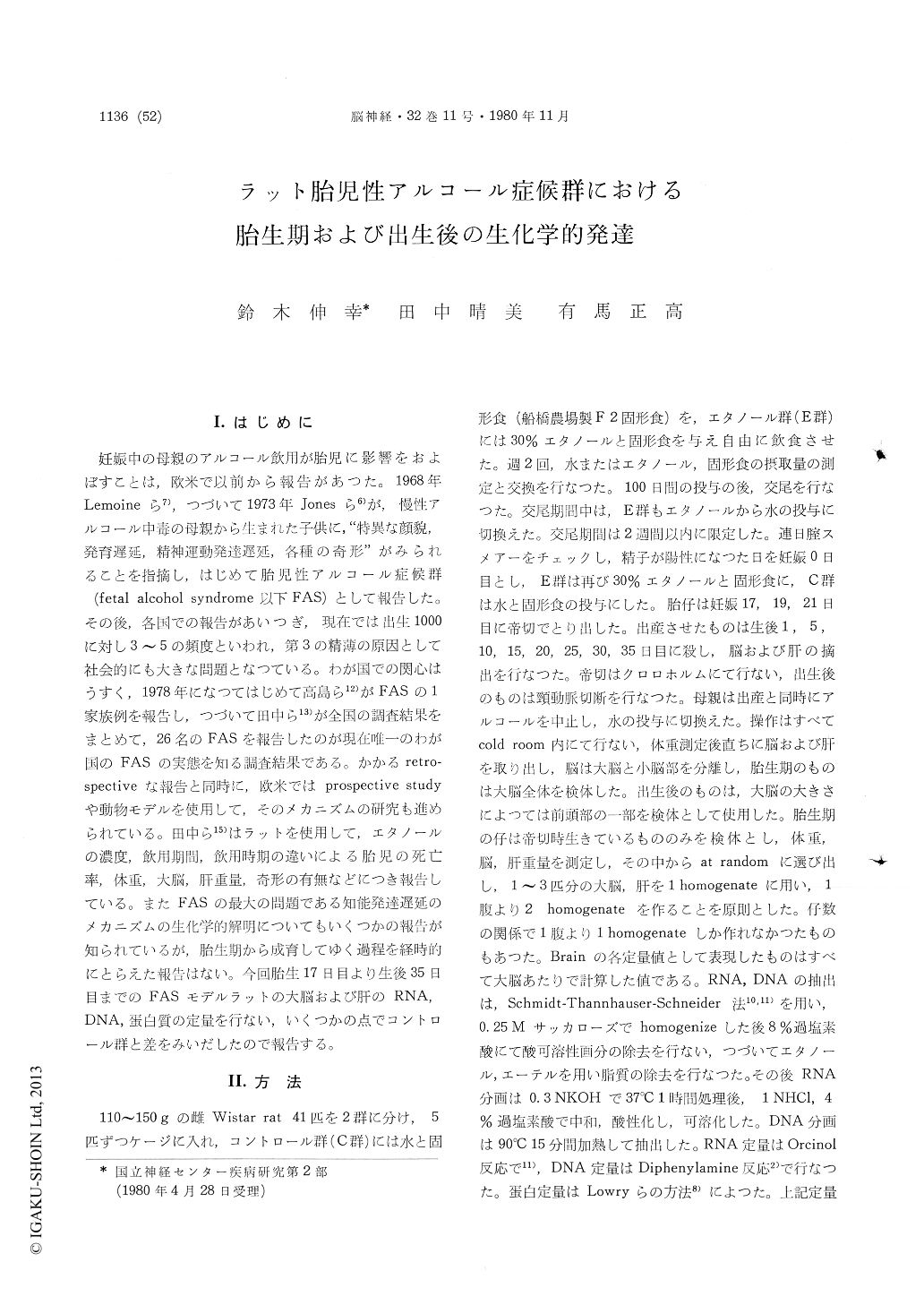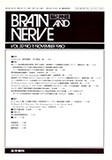Japanese
English
- 有料閲覧
- Abstract 文献概要
- 1ページ目 Look Inside
I.はじめに
妊娠中の母親のアルコール飲用が胎児に影響をおよぼすことは,欧米で以前から報告があつた。1968年Lemoineら7),つづいて1973年Jonesら6)が,慢性アルコール中毒の母親から生まれた子供に,"特異な顔貌,発育遅延,精神運動発達遅延,各種の奇形"がみられることを指摘し,はじめて胎児性アルコール症候群(fetal alcohol syndrome以下FAS)として報告した。その後,各国での報告があいつぎ,現在では出生1000に対し3〜5の頻度といわれ,第3の精薄の原因として社会的にも大きな問題となつている。わが国での関心はうすく,1978年になつてはじめて高島ら12)がFASの1家族例を報告し,つづいて田中ら13)が全国の調査結果をまとめて,26名のFASを報告したのが現在唯一のわが国のFASの実態を知る調査結果である。かかるretro—spectiveな報告と同時に,欧米ではprospective studyや動物モデルを使用して,そのメカニズムの研究も進められている。田中ら15)はラットを使用して,エタノールの濃度,飲用期間,飲用時期の違いによる胎児の死亡率,体重,大脳,肝重量,奇形の有無などにつき報告している。またFASの最大の問題である知能発達遅延のメカニズムの生化学的解明についてもいくつかの報告が知られているが,胎生期から成育してゆく過程を経時的にとらえた報告はない。
Mental retardation and stunted growth are obse-rved in the fetal alcohol syndrome (FAS) in human. In order to obtain some insights into the mechanism of offspring were experimentally studied in the rat.
Female Wistar rats of the experimental group (Group E) were provided 30% ethanol and solid diets ad lib for 100 days before mating and during the period of gestation. Control group (Group C) were given water and solid diets ad lib in the same period. In order to investigate fetal growth and development the abdomen of dams was opened and the fetuses were dissected out on 17, 19 and 21 gestational days. As to the postnatal growth and development, the offsprings were decapitated in 5-day-interval from 1st to 35th day after birth. Fetuses and offsprings were weighed, and brain and liver were rapidly removed. RNA, DNA and protein contents of the brain and liver were deter-mined by the orcinol, dipenylamine and Lowry methods respectively.
A significant decrease in the weights of body, brain and liver was observed in fetuses of the Group E, while it was less marked after birth. Total RNA contents of cerebrum in the Group E were low throughout the experimental period. RNA/gram wet weight of cerebrum was high in the fetuses of the Group E, but it reached to the same level as Group C after birth. A decrease in total RNA contents and an increase in RNA/gram wet weight of liver were observed only in the gestational period.
Total DNA contents of the cerebrum in fetuses of the Group E were low in the gestational period, but significant difference was not seen after birth.
DNA/gram wet weight of cerebrum was high until 1st day after birth in the Group E, but significant diference was not seen after that. Total DNA contents of the liver were low until 19th gestational day, but significant diference was not seen thereafter. DNA/gram wet weight of liver was not different in both groups throughout the experimental period.
In the fetuses of the Group E, total protein contents of the cerebrum and liver were lower while protein/gram wet weight in the cerebrum and liver was higher comparing with those in the cerebrum and liver was higher comparing with those in the fetuses of Group C. The changes were not detected after birth. After birth RNA/DNA ratio in the cerebrum and protein/DNA ratio in the cerebrum and liver were decreased in the offsprings of Group E.
In summary, in the gestational period when the fetuses had received a direct of maternal ethanol, both RNA and DNA in the fetal brain and liver decreased. On the other hand after delivery when dams did not drink ethanol, only RNA in the brain was continued to be low. These results appeared to indicate that both the cellular proli-feration and function in the fetuses were affected by maternal ethanol consumption and the disturbed cellular function of the brain persisted for a long time after birth.

Copyright © 1980, Igaku-Shoin Ltd. All rights reserved.


